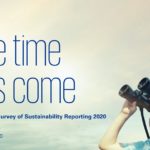CSR Network recently released Material World: The 2003 Benchmark Survey Report, a detailed research project evaluating global reporting among the 100 largest companies in the world, by revenue, as listed in the Fortune 500. The concept results from the simple proposition that global economic actors have global environmental and social impacts and should be encouraged to produce global, as opposed to national, environmental and social reports. For the first time this year the scope of the Survey has been expanded to include greater detail on global social and sustainability reporting as well as environmental reporting.
In addition to this report, more detailed results of the 2003 Survey, including sector and category analysis in the form of Research Reports, are available on request from csr network.
The 2003 Benchmark Survey research project analysed global reports and reporting available in English in the public domain during the period October 2002 to March 2003. This reporting encompasses 2001 and 2002 data. The 2003 Survey evaluated reporting by each company according to thirty-two reporting categories adding to and developing the extensive Benchmark Survey database, which has tracked reporting since 1999. (The previous Benchmark Survey was published in 2001. There was no Survey for 2002.)
The Benchmark Survey tracks how and what companies are reporting.
Key highlights include:
* In 2003, the most notable areas of increased reporting have been in the social categories. 25% of companies now produce integrated global social and environmental reports as opposed to 23% producing purely environmental global reports.
* The 2003 Survey measured a considerable interest in stakeholder engagement activities with 32% of companies reporting on a stakeholder engagement process. But many reporters still view stakeholder engagement as an end in itself rather than a means of obtaining perspectives and ideas that will be used to shape their business.
* 26% of companies now report their position with regard to human rights and labour practices.
* Health and safety reporting has risen from 39% of all reporters (17% of the total 100 companies) in 2000, to 48% of all reporters this year.
* Companies are increasingly addressing wider global issues that relate to their industry. 49% of companies reported on the sustainability of their product or service in 2003.
* While 75% of reporting companies are now reporting not only their global emissions, but also efforts to reduce these just 17% of reporting companies discuss mobile sources of CO2, such as company fleets, business travel and employee commuting.
* For the third year running, the Computers and Electronics sector has have the greatest percentage of reporters (90%). Reporting in the Automotive sector has grown in maturity over the last four years and is now level with the Computers and Electronics sector, with 90% of the sector also producing a global report.
* Despite the Financial Services and Merchandising sectors still being ranked seventh and eighth, out of eight, in the sector rankings, the Financial Services sector has increased its reporting fourfold since 1999, and this year has produced two leaders, AVIVA and HVB Group.
* Of the ten leading reporters, almost three quarters comment that they have taken the GRI guidelines into consideration when preparing the report.
* There is greater commitment to transparency through independent assurance; 18% of companies included independent assurance in their report, up from 8% in 2000.
* 76% of survey companies using independent assurance providers this year are European.
* The AA1000 Assurance Standard is emerging as the accepted framework for independent assurance.
Themes of interest
The following themes are addressed in the report:
Silent Sam non reporting in the US
* While industry sectors have a bearing on approaches to reporting, with some reporting more strongly than others (Computers & Electronics and Automotive sectors are strong, Financial Services, Merchandising, and Trading show less reporting), the 2003 Benchmark Survey has identified marked geographical differences in approaches to reporting that cut across sector boundaries.
* 62% of all non-reporting companies are domiciled in the US
* 70% of Asian companies publish a global environmental or social report. Japanese companies are traditionally strong environmental reporters.
* European companies account for 36% of the total number of companies, 69% of which publish a global environmental or social report. European companies display the greatest level of social and environmental or sustainability reporting.
* Despite these trends, three of the top ten reporting companies are domiciled in the U.S. Ford, General Motors and Suez. (Pages 27- 30 look at this in more detail).
Materiality
*Materiality is currently a hotly debated topic in the UK, in particular. In light of the governments Company Law Review, the DTI has set up a working group to review this issue and explore how directors can assess whether an item is material to their company and merit inclusion in an Operating and Financial Review (OFR)
*Social and Environmental Reporting is an expression of materiality in that companies have to decide what is important enough to include in such a report, and indeed whether environmental and social impacts warrant the publication of a report at all.
*One of the key aspects of company decisions around materiality is whose materiality are they considering. In the long term, many argue that stakeholder priorities and those of the company are the same.
* In order to understand what is material to stakeholders, companies need to engage with them. The Benchmark Survey evaluates the current level of engagement among the 100 companies. While many acknowledge that stakeholder engagement is now necessary, only a few are reporting that they are using engagement to inform decision making in the company.
* The new standard for independent assurance, AA1000 Assurance Standard, developed by AccountAbility, focuses on materiality and stakeholder engagement.
Reporting against new social and sustainability categories
*The previous Benchmark Survey in 2001 included five categories related to social reporting. Since then, integrated reporting has advanced. This years survey has been developed to give social and environmental reporting equal weighting and includes ten new social categories as well as one economic and two new environmental categories.
* The new categories are as follows: an integrated social and env. report, a global social policy, a global sustainability policy, senior responsibility for social issues, global social targets, global sustainability targets, stakeholder engagement processes, global social management systems, green house gas emissions mitigation, mobile sources of CO2, ethical trading, human rights, contributions or impacts on the local economies, dilemmas or conflicting priorities when addressing social, environmental and economic issues.
*26% of companies now report their position with regard to human rights and labour practices.
*Health and safety reporting has risen from 39% of all reporters (17% of the total 100 companies) in 2000, to 48% of all reporters this year.
*Companies are increasingly addressing wider global issues that relate to their industry. 49% of companies reported on the sustainability of their product or service in 2003.
*Economic indicators are still not widely reported on. 42% of reporting companies mentioned the difficult dilemmas facing them when trying to consider environmental, social and economic responsibilities. These include such issues and redundancy and construction over biodiversity.
*54% of reporting companies discussed their impacts on local economies, including taxes paid, employment creation, sourcing locally.
*The Global Reporting Initiative is a key driver for integrated sustainability reporting. 39% of reporting companies made reference to the GRI, whether or not they produced their report in accordance with the GRIs 2002 Sustainability Reporting Guidelines.
Vehicles for communication
(our findings on the use of the internet are not detailed in the report, although additional bespoke reports on this and other reporting issues are available on request)
*The internet is now the preferred tool for communicating social and environmental performance. This year the Benchmark Survey did not measure the number of companies using the internet as in previous years, as this is now almost a given. What was measured was how the companies prioritised their reporting within their corporate website. We found that 46% of companies had some environmental or social reporting (not necessarily a full global report) less than three clicks away from their home page.
*While the internet offers access to many, it also excludes a certain section of society that does not have access to the internet.
*The majority of reports are now presented as pdf files.
*Companies are now starting to produce both a pdf report and additional information posted on the website. As the categories or indicators against which companies are expected to report grows, companies are finding new ways of keeping their reporting short and manageable.
*Other companies such as BP have moved to internet only reporting and do not present their environmental and social impacts in the form of a contained pdf, but rather as a large website.
*One difficulty that stakeholders will experience with web based reporting, apart from lack of access for some, is the ease with which sites can be changed. This is both an advantage and a disadvantage to stakeholders. One the one hand companies can keep information updated and inform readers of the latest performance data, but on the other hand holding the company to account can be less easy when targets or policies can be removed without warning.
The Benchmark Survey 2003 research project was conducted by csr network with the assistance of its partner organisation in the U.S., Cameron-Cole, LLC.


